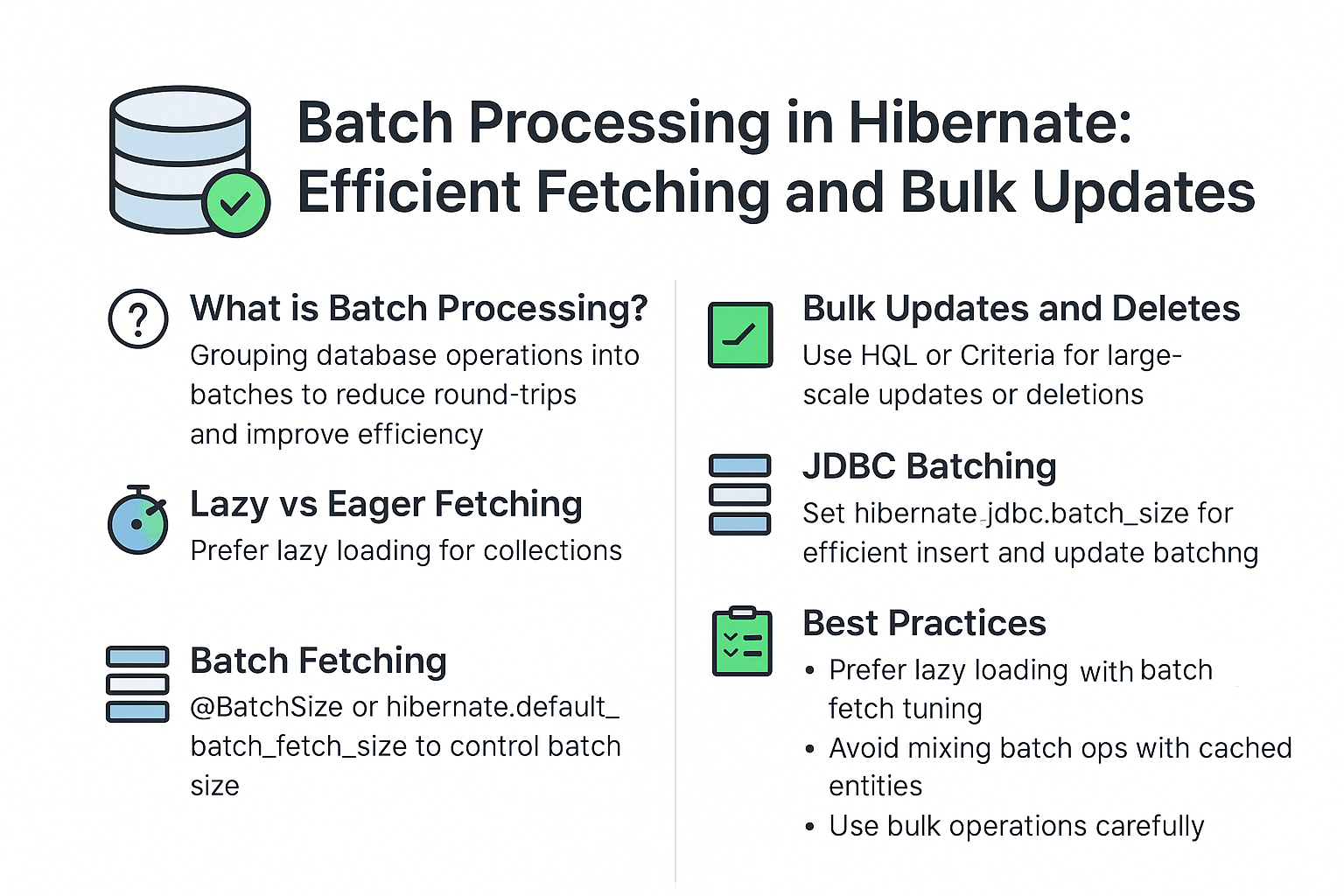When working with large datasets in enterprise applications, performance and efficiency become critical. Hibernate, one of the most popular ORM frameworks in Java, offers batch processing features that drastically improve performance for fetching large volumes of data and executing bulk updates or deletes.
Think of batch processing in Hibernate as ordering groceries in bulk instead of making individual trips—you save time, resources, and reduce overhead.
What is Batch Processing in Hibernate?
Batch processing in Hibernate refers to the practice of grouping multiple database operations together into batches rather than executing them individually. This reduces the number of round-trips to the database and improves efficiency.
Two main areas where batch processing helps:
- Fetching large collections or entities efficiently.
- Bulk Updates/Deletes without loading every entity into memory.
Hibernate Fetching Strategies for Batch Processing
Hibernate provides different fetching strategies that can be tuned for performance.
1. Lazy vs Eager Fetching
- Lazy Loading (default): Data is fetched only when accessed.
Analogy: Like ordering food only when you’re hungry. - Eager Loading: Data is fetched immediately with the parent entity.
Analogy: Like pre-ordering everything at once, even if you may not need it.
Best Practice: Prefer Lazy Loading for collections to avoid the N+1 problem.
2. Batch Fetching with @BatchSize
@BatchSize helps reduce the number of queries by batching lazy-loaded collections.
@Entity
@Table(name = "students")
@BatchSize(size = 20)
public class Student {
@Id
@GeneratedValue(strategy = GenerationType.IDENTITY)
private Long id;
private String name;
}
Here, when you fetch a student and access multiple lazy-loaded students, Hibernate fetches them in batches of 20 instead of individual queries.
3. hibernate.default_batch_fetch_size
You can also configure batching globally:
hibernate.default_batch_fetch_size=30
This tells Hibernate to fetch collections and proxies in batches of 30.
Bulk Updates and Deletes in Hibernate
Instead of loading each entity into memory, Hibernate allows bulk operations directly using HQL or Criteria.
Example: Bulk Update
Transaction tx = session.beginTransaction();
String hql = "UPDATE Employee e SET e.salary = e.salary * 1.1 WHERE e.department = :dept";
int rowsUpdated = session.createQuery(hql)
.setParameter("dept", "IT")
.executeUpdate();
tx.commit();
System.out.println("Rows updated: " + rowsUpdated);
Example: Bulk Delete
Transaction tx = session.beginTransaction();
String hql = "DELETE FROM Employee e WHERE e.contractExpired = true";
int rowsDeleted = session.createQuery(hql).executeUpdate();
tx.commit();
System.out.println("Rows deleted: " + rowsDeleted);
⚠ Warning: Bulk operations bypass Hibernate’s first-level cache and entity lifecycle methods (@PreUpdate, @PreRemove). Use them carefully.
Session, Transaction, and JDBC Batching
Hibernate internally uses JDBC batching to optimize insert/update operations.
hibernate.jdbc.batch_size=50
hibernate.order_inserts=true
hibernate.order_updates=true
hibernate.jdbc.batch_size=50: Groups 50 insert/update statements in a single batch.hibernate.order_inserts=true: Reorders inserts to improve batching efficiency.hibernate.order_updates=true: Groups updates by entity type.
Example: Batch Insert
Session session = sessionFactory.openSession();
Transaction tx = session.beginTransaction();
for (int i = 1; i <= 1000; i++) {
Employee emp = new Employee("Emp " + i, "IT", 5000);
session.save(emp);
if (i % 50 == 0) {
session.flush();
session.clear();
}
}
tx.commit();
session.close();
Here, Hibernate inserts 1000 employees in batches of 50, reducing memory overhead.
Real-World Use Cases
- Importing bulk data into a database.
- Updating salaries or attributes of thousands of employees at once.
- Cleaning up expired records periodically.
- Lazy-loading with batch fetch size in reporting systems.
Common Pitfalls & Anti-Patterns
-
N+1 Select Problem
Occurs when each entity loads its collection individually. Fix using@BatchSizeorJOIN FETCH. -
Eager Fetching Everything
Leads to performance bottlenecks. Avoid unless absolutely required. -
Improper Batch Size
Too small = many queries, too large = memory overhead. -
Bulk Updates Bypassing Lifecycle
Remember that bulk HQL/SQL skips entity-level events.
Best Practices
- Always use Lazy Loading with batch size tuning.
- Set
hibernate.jdbc.batch_sizeto a reasonable value (20–50). - Clear the session periodically during large inserts/updates.
- Avoid mixing batch operations with cached entities.
- Use bulk operations only when entity lifecycle callbacks are not required.
📌 Hibernate Version Notes
Hibernate 5.x
- Relies on legacy
javax.persistenceAPIs. - SessionFactory setup via
hibernate.cfg.xmlor Spring Boot config. - HQL and Criteria API available.
Hibernate 6.x
- Migrated to
jakarta.persistencepackage. - Improved SQL generation and query plan caching.
- Enhanced
CriteriaandHQLquery APIs. - Better support for multi-tenancy and stored procedures.
Tip: If migrating from Hibernate 5 → 6, update all imports from javax.persistence.* to jakarta.persistence.*.
Integration with Spring Boot
Spring Boot simplifies Hibernate batch processing setup.
spring:
jpa:
properties:
hibernate:
jdbc:
batch_size: 30
order_inserts: true
order_updates: true
hibernate:
ddl-auto: update
Repositories can then leverage batch inserts/updates automatically when saving lists of entities.
Conclusion & Key Takeaways
- Hibernate batch processing is crucial for performance when handling large datasets.
- Use
@BatchSizeorhibernate.default_batch_fetch_sizefor fetching optimization. - Configure
hibernate.jdbc.batch_sizefor inserts/updates. - Apply bulk HQL/SQL updates for large modifications, but beware of bypassed lifecycle events.
- Always test batch size configurations under real workloads for the best results.
FAQ: Expert-Level Questions
Q1: What’s the difference between Hibernate and JPA?
Hibernate is an implementation of JPA (Java Persistence API) but also offers advanced features beyond the specification.
Q2: How does Hibernate caching improve performance?
By storing frequently accessed entities in memory (L1, L2 cache), Hibernate reduces database calls.
Q3: What are the drawbacks of eager fetching?
It may load unnecessary data, causing memory and performance issues.
Q4: How do I solve the N+1 select problem in Hibernate?
Use @BatchSize, JOIN FETCH, or EntityGraph.
Q5: Can I use Hibernate without Spring?
Yes, Hibernate can be used standalone with SessionFactory configuration.
Q6: What’s the best strategy for inheritance mapping?
It depends: SINGLE_TABLE for performance, JOINED for normalization, TABLE_PER_CLASS for isolation.
Q7: How does Hibernate handle composite keys?
By using @Embeddable and @EmbeddedId or @IdClass.
Q8: How is Hibernate 6 different from Hibernate 5?
Hibernate 6 uses jakarta.persistence, offers better SQL support, and improves query API consistency.
Q9: Is Hibernate suitable for microservices?
Yes, but lightweight alternatives (e.g., jOOQ, MyBatis) may be preferred for smaller services.
Q10: When should I not use Hibernate?
Avoid Hibernate when raw performance and fine-grained SQL control are required, such as in analytics-heavy applications.
